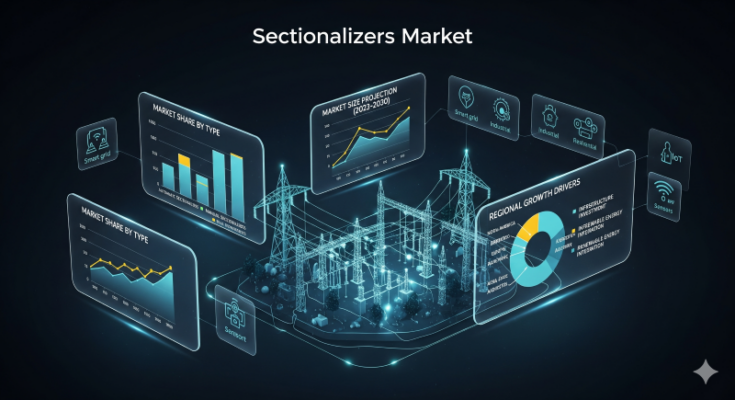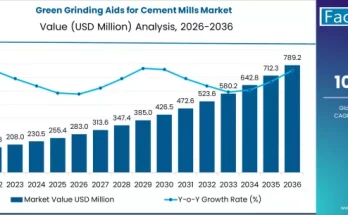The modern power distribution network faces increasing demands for reliability, efficiency, and safety. In this context, sectionalizers have emerged as critical devices for automated fault isolation in electrical distribution systems. They are instrumental in improving service continuity, reducing outage times, and minimizing maintenance costs. As the energy sector embraces smart grids and renewable integration, the sectionalizers market is witnessing notable growth worldwide. This expansion is driven by increasing electricity demand, aging infrastructure upgrades, and rising investments in smart distribution technologies.
Market Overview:
Sectionalizers are electrical devices that automatically isolate faulted sections of a distribution line, coordinating with reclosers and circuit breakers to improve network stability. By minimizing the impact of faults on the overall system, sectionalizers enhance reliability and safety for end users. The market encompasses a range of products categorized by voltage level, type of operation, and mounting configuration. Innovations in sectionalizer technology, such as remote monitoring capabilities, digital integration, and compact designs, are further expanding their applications in modern grids.
Key types include electromechanical, electronic, and smart sectionalizers, each offering distinct advantages. Electromechanical sectionalizers are robust and widely used in traditional networks, whereas electronic and smart variants provide advanced monitoring, improved fault detection, and seamless integration with automated grid management systems.
Regional Insights:
North America is at the forefront of sectionalizer adoption, driven by the modernization of power distribution networks and the expansion of smart grid projects. Utility companies are increasingly investing in automation devices to enhance reliability and reduce downtime.
Europe follows closely, propelled by stringent energy regulations, renewable energy integration, and initiatives to modernize aging grids. Governments and private utilities are promoting technologies that optimize distribution network performance and improve fault response mechanisms.
Asia-Pacific is emerging as a high-growth market, supported by rapid urbanization, industrialization, and increasing electricity demand. Countries in the region are modernizing rural and urban power distribution systems to enhance reliability, making sectionalizers a key component of grid expansion projects.
Key Trends & Forecast:
- Smart Grid Integration:
The adoption of smart grids is driving demand for sectionalizers that can communicate with control systems, provide real-time data, and facilitate predictive maintenance. - Renewable Energy Integration:
As distributed energy resources (DERs) like solar and wind become prevalent, sectionalizers help manage bi-directional power flows, ensuring reliability in grids with variable energy sources. - Automation & Remote Monitoring:
Advanced sectionalizers now feature remote control and monitoring capabilities, enabling utilities to identify faults quickly and take corrective actions without manual intervention. - Compact & Modular Designs:
Modern sectionalizers are increasingly compact, allowing easy installation in urban areas and limited-space environments. Modular designs also simplify maintenance and scalability. - Durability & Weather Resistance:
With deployment across diverse environments, sectionalizers are designed to withstand harsh conditions, including extreme temperatures, humidity, and mechanical stress, ensuring reliable performance in challenging settings.
Product Segmentation:
The market is typically segmented by type, voltage level, and mounting configuration:
- By Type: Electromechanical, electronic, and smart sectionalizers. Each type serves different operational needs, from traditional networks to fully automated smart grids.
- By Voltage Level: Low, medium, and high-voltage sectionalizers cater to various distribution requirements, ensuring compatibility with residential, commercial, and industrial applications.
- By Mounting Configuration: Pole-mounted, pad-mounted, and indoor-mounted sectionalizers provide flexible installation options for diverse environments, ranging from urban distribution networks to remote rural areas.
Applications & End-Use Outlook:
Utilities & Power Distribution Companies:
Sectionalizers are primarily used by utility companies to enhance grid reliability, reduce outage duration, and optimize maintenance schedules.
Industrial & Commercial Facilities:
Large industrial plants and commercial complexes utilize sectionalizers to ensure uninterrupted power supply and protect critical equipment from outages.
Renewable Energy Networks:
Sectionalizers play a vital role in integrating renewable energy sources by isolating faulted sections and maintaining stability in distributed energy systems.
Urban & Rural Electrification Projects:
Governments and private enterprises deploying urban and rural electrification projects are increasingly incorporating sectionalizers to improve service reliability and minimize downtime.
Competitive Landscape:
The sectionalizers market is competitive, with both global and regional players focusing on innovation, reliability, and performance. Leading manufacturers are investing in R&D to introduce products that offer advanced fault detection, automated control, and seamless integration with smart grid infrastructure. Collaborations with utility providers, technological partnerships, and strategic acquisitions are common strategies to strengthen market presence.
Key trends in the competitive landscape include:
- Development of next-generation smart sectionalizers with IoT connectivity.
- Introduction of modular designs for easier installation and maintenance.
- Strategic partnerships with utilities and technology providers for grid modernization projects.
Challenges & Opportunities:
Challenges:
- High initial investment costs for smart sectionalizers can be a barrier in some regions.
- Integration with legacy infrastructure may require technical expertise and additional costs.
- Regulatory and compliance requirements vary across regions, impacting market entry and expansion.
Opportunities:
- Expanding smart grid projects globally present substantial growth potential.
- Increasing adoption of renewable energy networks and distributed energy systems boosts demand for advanced sectionalizers.
- Emerging markets in Asia, Africa, and South America offer untapped opportunities for manufacturers and suppliers.
Future Outlook:
The sectionalizers market is poised for steady growth as utilities and industries focus on reliable and automated power distribution. The ongoing shift towards smart grids, renewable energy integration, and automation will drive demand for advanced sectionalizers capable of real-time monitoring, predictive maintenance, and remote operation. Manufacturers that can provide durable, technologically advanced, and cost-effective solutions will capitalize on emerging market opportunities.
The combination of urbanization, industrialization, and government initiatives to modernize electrical infrastructure worldwide ensures that sectionalizers will remain an essential component in achieving efficient and reliable power distribution.
Conclusion:
Sectionalizers are critical for modern power distribution networks, enabling utilities and industries to maintain continuity, safety, and efficiency. With growing investments in smart grids, renewable energy integration, and grid automation, the sectionalizers market is expected to witness strong growth in the coming years. By focusing on innovation, durability, and integration capabilities, manufacturers can position themselves for success in a dynamic and expanding global market.
Utilities, industrial operators, and stakeholders in the energy sector must leverage insights from sectionalizer market trends to optimize operations, improve service reliability, and support sustainable power distribution strategies.



